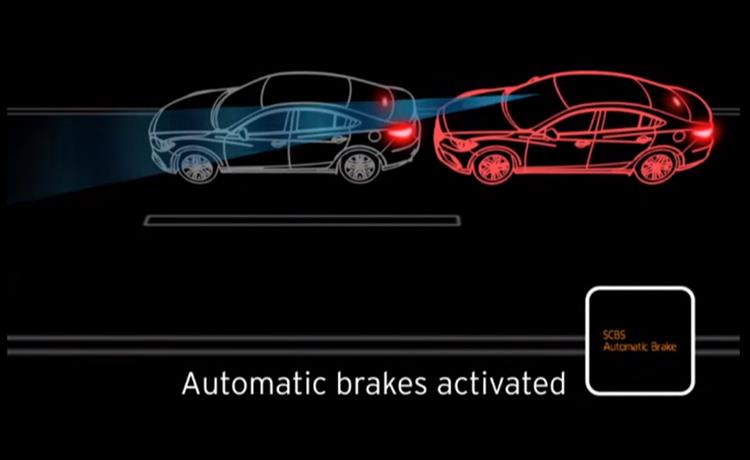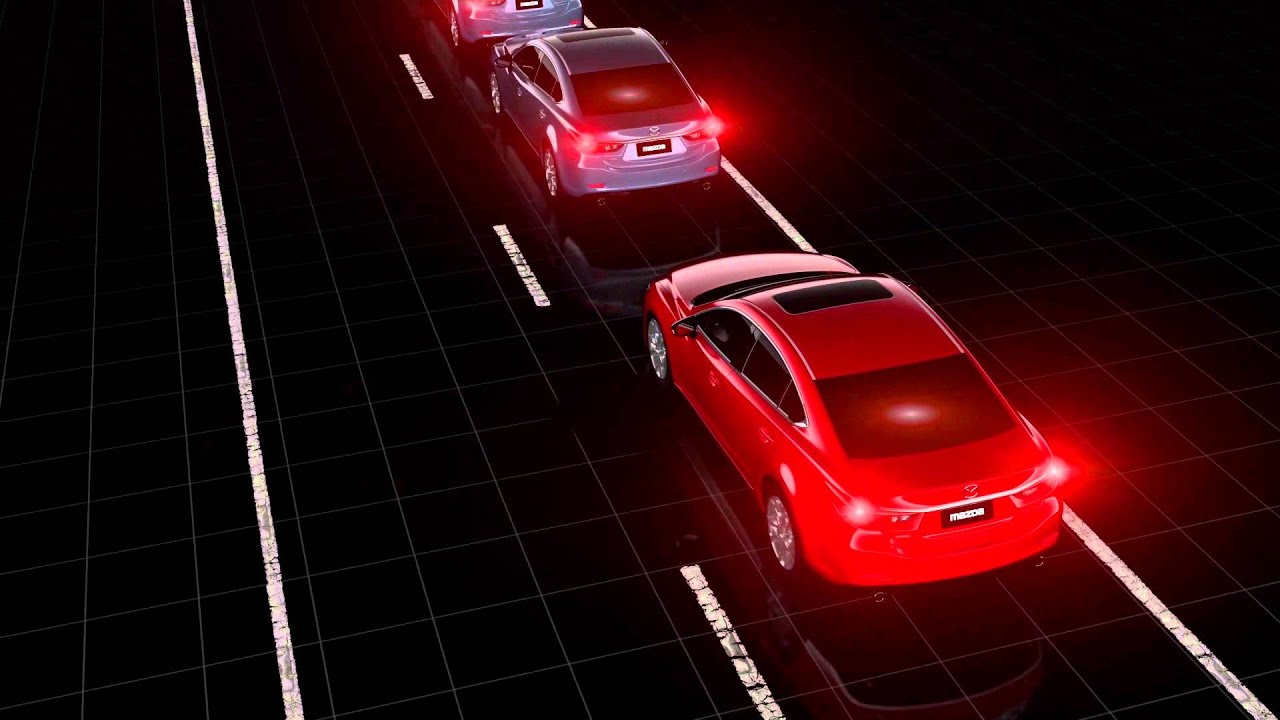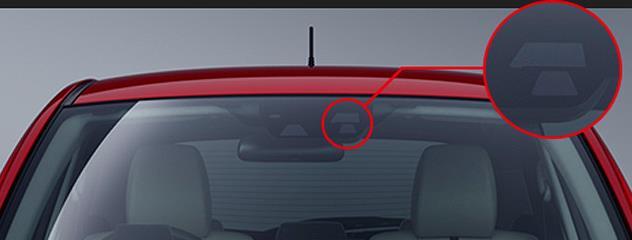
Smart City Brake Support is a system that is purposely designed to help drivers prevent rear-end collisions while driving at slow speeds, especially in congested traffic or urban areas. Therefore, Smart City Brake Support is ideal for drivers who frequent places with urban congestion and heavy traffic. Studies show that frontal collisions are the common form of accidents, and about 60% of the accidents occur at considerably low speeds of 30 km/h or less. With the SBCS, a laser sensor is mounted on the windscreen to sense the car in front while driving at low speeds (about 4 to 30 km/h).
The system prepares the brake system to provide maximum braking power if the driver brakes after the SBCS detects a risk of collision. Moreover, the system reduces engine output and applies brakes simultaneously if the driver fails to take any action such as steering or braking to avoid the crash. This helps reduce the severity of impact or prevent the collision.
How Smart City Brake Support (SCBS) Works

The system uses a near-infrared laser mounted on a windscreen that helps detect cars in front of the vehicle. It is incredibly accurate over short distances and works best at low speeds of about 4 to 30 km/h by controlling the braking system if there is a higher risk of collision. Therefore, the system assists the driver when he or she applies the brakes by increasing the force of braking instantly.
The system is also designed to brake automatically when the driver fails to apply brakes to help reduce the severity of impact or avoid a collision. Moreover, the Smart City Brake System (Forward) system is also equipped with the Acceleration Control for AT. The Acceleration Control cuts off the engine power and sounds an alarm when the driver presses the accelerator pedal as if he or she intends to brake when the car is crawling at low speeds below 10 km/h or when it is stopped. This helps prevent the vehicle from lurching forward.
It also includes the Smart City Brake System (Reverse) applies two ultrasound sensors that are fixed on the car’s bumper to avoid obstacles when reversing the car at low speeds of about 2 to 8 km/h. The system automatically applies the brakes when there is a risk of collision, which helps reduce the impact of the collision or avoid it.
Besides, the SCBS R is also equipped with Acceleration Control for AT. The feature cuts off the engine power and sounds an alarm if you press the accelerator pedal suddenly as if you want to brake while the car is reversing at low speeds that do not exceed 10 km/h or when stopped. This helps prevent the car from lurching backward.
How to Test Smart Brake Support
Smart Brake Support is a unique safety feature that comes handy for drivers who frequent cities with congestion and heavy traffic. The new collision avoidance or mitigation system operates at low car speeds to help reduce the damage that would result from any impact. Therefore, it is essential to learn how to test whether the system is functioning as required to ensure that your car gets protection from collisions.
Usually, the Smart Brake Support works well at speeds of about 2 to 18 mph. This means at the specified speed the system is capable of entirely preventing an accident between your vehicle and the car behind if the relative speed between them is less than 9.3 mph.
However, there are some disclaimers when it comes to how and when the Smart City Brake system might not work. These include incidents involving cyclists and pedestrians. The Smart Brake Support may also not perform normally due to some factors like bad weather (snow, rain, and fog), shape of the car in front (some shapes fail to reflect radar properly) and road conditions (undulations, multiple curves). In addition, the system is not available in all in all markets or models, though it is common in most of the latest Mazda cars.
Mazda Smart City Brake Support

The SCBS detects the car in front using a laser sensor mounted at the windscreen. It has the ability to sense a potential collision when the vehicle is traveling at a speed that is below 18 miles per hour. If the SCBS system detects a risk of a crash, it prepares your car’s brakes to stop your vehicle effectively and quickly or applies the brakes automatically if you fail to apply them yourself.
Mazda is a car model that is known for its upscale design, great performance and its intelligent safety technology. The model is equipped with the i-ACTIVSENSE safety package, which is the best-advanced safety technology in Mazda and it is available across the entire lineup.
How do the I-ACTIVSENSE Advanced Safety Features work?
- Smart City Brake Support
It detects inherent collisions in front of your car using a sensor that is mounted on the windshield when traveling at low speeds. The system increases the braking power to your brakes if the driver fails to take any action to prevent the collision by applying the brakes and reducing the engine power automatically.
- Adaptive Front-lighting System
The system is purposely designed to illuminate a greater distance for safe and comfortable driving by directing the headlights towards where the driver is traveling.
- High-Beam Control
The High-Beam Control switches between low and high beams based on preceding and oncoming traffic.
- Blind Spot Monitoring
As the name suggests, the feature enables you to detect vehicles or obstacles that may be in the blind spot of your car using the radars.
- Radar Cruise Control
The Radar Cruise Control allows your vehicle to maintain a safe distance between it and the car in front by using a millimeter wave radar. It also features the (DRSS) Distance Recognition Support System that shows the following range to the driver.
- Forward Obstruction Warning
The advanced safety feature alerts the driver of any risky situations by calculating the distance between the front of the vehicle and objects.
- Lane Departure Warning System
This system detects road markings, which ensures that the driver remains aware of their on the road.
- Rear Vehicle Monitoring System
It uses a radar sensor mounted on the rear bumper to determine the distance between your car and the one following you. The system alerts you in case of any potentially dangerous situations.
Conclusion
Overall, Smart City Brake Support comes in handy in avoiding any potentially risky situations such as frontal collisions while driving at the low speeds, especially in congested traffic or urban areas. It prepares the brake system to offer maximum stopping power, reduces engine output, and applies brakes automatically if the driver fails to take evasive action like steering or braking. However, it is good to mention that the system should not be taken a replacement for attentive and safe driving although significantly help in averting potential accidents.

Denis is an article/blog and content writer with over 7 years of experience in writing on content on different niches, including product reviews, buyer’s guide, health, travel, fitness, technology, tourism. I also have enough experience in SEO writing.













